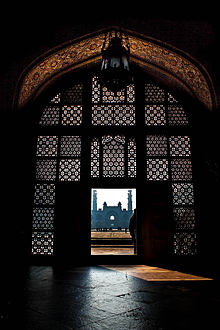భారతదేశంలో సెక్యులరిజం
ఈ వ్యాసం యొక్క ప్రధాన వస్తువు పరిచయము లేని వారికి వ్యాసం యొక్క పరిచయం లేదా ప్రవేశిక అరకొరగా ఉన్నది. ప్రవేశికను వికీపీడియా ప్రమాణాలకు అనుగుణంగా మెరుగుపరచటానికి సహాయం చెయ్యండి. దీని గురించి చర్చాపేజీలో చర్చించవచ్చు. |

భారతదేశంలో సెక్యూలరిజం, భారతదేశంలో సెక్యులరిజం గురించి తెలుసుకునే ముందు, సెక్యూలరిజం గురించి తెలుసుకోవడం ముఖ్యం.

సెక్యులరిజం (Secularism) అనేది ఒక 'స్వేచ్ఛాయుత ఆలోచన', దీని ప్రకారం, కొన్ని కార్యాచరణాలు లేదా సంస్థలు, మతము లేదా మతముల విశ్వాసాల నుండి వేరుగా యుంచుట. అనగా ప్రజల లేదా వ్యక్తిగత మతపరమైన మార్గాలనుండి లేదా మతపరమైన భావనలకు ప్రత్యామ్నాయంగా సెక్యులర్ భావాలను పెంపొందించుట.
ఒక విధంగా చెప్పాలంటే, సెక్యులరిజం ప్రకారం, మతపరమైన చట్టాలు, ప్రబోధనలనుండి స్వేచ్ఛపొందడం. ఇవి రాజ్యాలకు మాత్రమే పరిమితం. అనగా ప్రజలు వ్యక్తిగతంగా మతపరమైన విషయాలు పాటించిననూ, రాజ్యమునకు మతపరమైన విషయాలనుండి దూరంగా వుండేటట్లు చేయగలిగే స్థితి. ఒక రాజ్యంలో వుండే అనేక మతస్థులు, దేశ, రాజ్య, పరిపాలనా విషయాల పట్ల అందరికీ ఆమోదయోగ్యమైన సూత్రాలను తయారు చేసి శాంతి సౌఖ్యాలను స్థాపించుట. రాజ్యం విషయంలోనూ, రాజ్య పరిపాలనా విషయంలోనూ మతానికి అతీతంగా, సామాజిక సత్యాల పట్ల అవగాహన పొంది, రాజ్య, ప్రజా హితం కొరకు పాటు పడుట.[1]


వెరసి, ఒక మతరహిత ప్రభుత్వం గల దేశంలో అనేక మతముల వారు, మతపరమైన స్వేచ్ఛతో జీవనం సాగించే సిద్ధాంతం. భారత్ ఇదేకోవకు చెందుతుంది. ఈ విధానాన్నే భారతదేశంలో సెక్యులరిజం అని నిర్వచించవచ్చు.
భారతదేశం - లౌకికరాజ్యం
[మార్చు]1976 లో జరిగిన భారత రాజ్యాంగ 42వ సవరణ ప్రకారం,[2] భారత రాజ్యాంగ పీఠిక లో "భారత్ ఒక లౌకిక (సెక్యులర్) రాజ్యము" అని ప్రకటింపబడినది.
ప్రస్తుత పరిస్థితి
[మార్చు]భారత రాజ్యాంగంలోని 7వ షెడ్యూల్ మతపరమైన సంస్థలు, స్వచ్ఛంద సంస్థలు, ట్రస్ట్లను ఏకకాలిక జాబితాలో ఉంచుతుంది, అంటే భారత ప్రభుత్వం భారతదేశంలోని వివిధ రాష్ట్ర ప్రభుత్వాలు మతపరమైన సంస్థలు, స్వచ్ఛంద సంస్థలు, ట్రస్ట్ల గురించి వారి స్వంత చట్టాలను రూపొందించుకోవచ్చు. కేంద్ర ప్రభుత్వం రూపొందించిన చట్టానికి, రాష్ట్ర ప్రభుత్వ చట్టానికి మధ్య వైరుధ్యం ఏర్పడితే కేంద్ర ప్రభుత్వ చట్టం అమలులో ఉంటుంది. భారతదేశంలో మతం, రాష్ట్ర విభజన కంటే ఈ అతివ్యాప్తి సూత్రం 1956లో ఆర్టికల్ 290తో ప్రారంభమయ్యే రాజ్యాంగ సవరణల శ్రేణిలో గుర్తించబడింది, 1975లో భారత రాజ్యాంగ ప్రవేశికకు 'సెక్యులర్' అనే పదాన్ని జోడించడం జరిగింది..[3][4]
విమర్శలు
[మార్చు]భారత దేశంలో సెక్యులరిజం చాలా వివాదాస్పద అంశంగా మారింది. సెక్యులర్ రాజ్యాలుగా ప్రకటించుకున్న చాలా దేశాలు మతాన్ని రాజ్యం నుంచి వేరు చెయ్యగా మన దేశంలో మాత్రం అన్ని మతాలకి ప్రాధాన్యత ఇవ్వడమే సెక్యులరిజం అని నమ్మించడం జరుగుతోంది.
ఆ(నా)స్తికుల విమర్శలు
[మార్చు]ప్రభుత్వం సెక్యులరిజం పేరుతో నడుపుతున్న వోటు బ్యాంక్ రాజకీయాలను విమర్శితున్నారు. ఇలాంటి రాజకీయల వల్ల మెజారిటీలు, మైనారిటీల మధ్య విభేదాలు ఏమాత్రం తొలగవని వీరు అభ్యంతరం చెపుతున్నారు. ఉదాహరణ: ప్రపంచంలోని ఏ ముస్లిం దేశంలోనూ హజ్ యాత్రకు సబ్సిడీలు ఇవ్వరు. సెక్యూలర్ దేశమని చెప్పుకునే భారత దేశంలో ఇలాంటి వాటిని అధికారికంగా ప్రోత్సహించడం చాలా హాస్యాస్పదం అని ఆ(నా)స్తికులు విమర్శిస్తున్నారు.
ఇవీ చూడండి
[మార్చు]మూలాలు
[మార్చు]- ↑ Kosmin, Barry A. "Contemporary Secularity and Secularism." Secularism & Secularity: Contemporary International Perspectives. Ed. Barry A. Kosmin and Ariela Keysar. Hartford, CT: Institute for the Study of Secularism in Society and Culture (ISSSC), 2007.
- ↑ "The Constitution (Forty-Second Amendment) Act, 1976". Government of India. Archived from the original on 28 మార్చి 2015. Retrieved 1 December 2010.
- ↑ ఉల్లేఖన లోపం: చెల్లని
<ref>ట్యాగు;Larsonఅనే పేరుగల ref లలో పాఠ్యమేమీ ఇవ్వలేదు - ↑ Rajagopalan (2002), “Secularism in India”, in Editor: William Safran, The Secular and the Sacred - Nation, Religion and Politics, Chapter 13, ISBN 978-0714683010
బయటి లింకులు
[మార్చు]- India: Secularism and Freedom of Religion University of Vermont, United States
- Legalizing Religion: Indian Supreme Court and Secularism Ronojoy Sen, University of Hawaii
- India as a Secular State Donald E Smith, Read Online version, Princeton University Press - provides a pre-1963 historical Indian perspective on secularism
- Domenic Marbaniang, Secularism in India
- Republic of India - Legal systems, constitutional history and secularism Emory Law School, Atlanta
